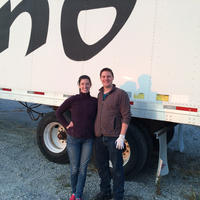Featured: Tiny House, Big Dreams
Back in June, we were featured in an article on American Modern (www.amig.com). The article was so beautifully written, I almost cried. I want to keep it forever so I'm posting it here.
"
Tiny House, Big Dreams
Most people don’t need a commercial driver’s license for a house. Noah and Tabatha Mehl, of Cincinnati, just might. They’re building a tiny house out of a 53-foot semi-trailer.
For many Millennials, shedding unnecessary goods and focusing on the basics of living is, well, liberating. In an era when so many young adults are facing crushing student loan debt, uncertain job prospects and rampant consumerism, the cheap, sustainable living afforded by moving into a tiny house can seem quite appealing.
A shift in consciousness.
The Mehls — he an IT professional and she a graphic designer — are big dreamers, even if their new home will be small. At first, they thought, not now.
“But it really became, ‘Why not now?’” Tabatha explained. “We’re sick of our apartment. We have too much stuff. This is a really motivating way to pare that down. As the process went on, it becomes easier and easier to look at things differently and say, ‘I never wear that,’ or ‘I don’t really need to own that. I don’t need to consume as much as I used to.”
“Do I really need plates for twelve?,” Noah chimed in. “Do I really need four kinds of glasses?”
Tabatha shook her head. “All we really need is room to work and room for the dogs.”
Home sweet box-within-a-box.
The Mehls are designing and building their truck trailer home one step at a time. First came the steel frame. Then came the insulation. The wood pellet-burning furnace was next.
“We’re doing everything we can — over-engineering it — to give us the most stable structure,” Tabatha said.
In a former existence, Noah studied theater set design. He has built (quite literally) on knowledge experientially gained.
“I had to learn how to draft. I had to learn how to CAD. I had to build steel structures. We had to do material [and] structural engineering. Technically, none of us were licensed,” he explained. “And there’s this function of, ‘it’s good enough.’”
But does that translate to cutting corners during construction? Not at all, my study, not at all.
The Mehls are designing and building to the same strict HUD regulations that govern traditional mobile homes. That will give their structure stability not only when stationary, but whenever it is taken on the open road. It’s not easy.
“Under HUD, I have to anchor [the furnace] to the sub-frame,” Noah acknowledged. “I have to drill through all of my framing and the I-beams below it. “
“See?,” Tabatha laughed. “I just learned something new!”
And that’s the true beauty of the project: Noah and Tabatha aren’t just learning how to design and build their dream home. They’re learning about themselves. They’re deepening their relationship.
“It’s already been rewarding to have an understanding of how my house is structured and built,” Tabatha said, “and to know that, hey, I screwed in this floor. There are a lot of things I can do.”
“We’re bootstrapping our marriage,” Noah agreed. “We’re saying, ‘What’s the absolute minimum we need now?,’ and then we’ll iterate.”
A place not to sleep, but to be.
Section by section. Highest priorities first. Front to back. That’s how they’re building.
The bedroom is going in now. But Tabatha works from home, so it must double as her workspace. Their Murphy bed will swing up and a desk will flip down. There’ll be plenty of natural light from several large windows.
The galley kitchen — complete with dishwasher, full-size refrigerator and sink — will go next. Then the shower stall. A separate water closet.
A utility closet, which will enclose the furnace and water pumps. Banks of batteries that will allow the couple to live off-grid for several weeks at a time. Black and grey water composting. A tankless water heater. And the exterior chimney will unbolt from the structure, so that the trailer can remain street-legal when moved.
Lastly, the multi-purpose space, which will occupy the back third of the trailer. It will have a couch. Recessed lighting. Shelving. Maybe (eventually) a crib.
“It’s a fine line between what’s an RV and what’s a tiny home,” Noah cautioned. “What makes it a tiny home is that the king-sized bed is also the desk, that the couch will probably double as a guest bed.”
“No wasted square footage,” Tabatha said.
Some of that square footage will probably be used to store removable ramps and chocks that would allow the Mehls to drive in and secure a smart car, Elio, or three-wheeler during long haul moves. Once they get wherever they’re going, they want to be able to move freely.
That’s the whole point of their tiny house. Freedom.
Alaska. California. Home is where the heart wants to go.
“If I want to go to California, the idea is that I pay a logistics company to move this from Point A to Point B and then I arrive when it gets there,” Noah said. “I just show up. Fly over there, ‘Hey! I’m home.’ That would be awesome.”
The other option — purchasing a truck cab and getting a CDL — isn’t off the table. Nor is eventually putting down roots.
“We do plan in the future to buy land and set it there when we’re not travelling,” Tabatha elaborated. “Eventually maybe build another tiny home and this can be a suite for guests.”
Until then, the call to live en plein air rings loudly for both of them.
“We’ve always talked about going and seeing the Northern Lights,” she said, with a smile. “We often say it would be lovely to go to Alaska someday and stay warm.”
"
Original post can be seen here: www.amig.com/livingwise/tiny-house-big-dreams/


